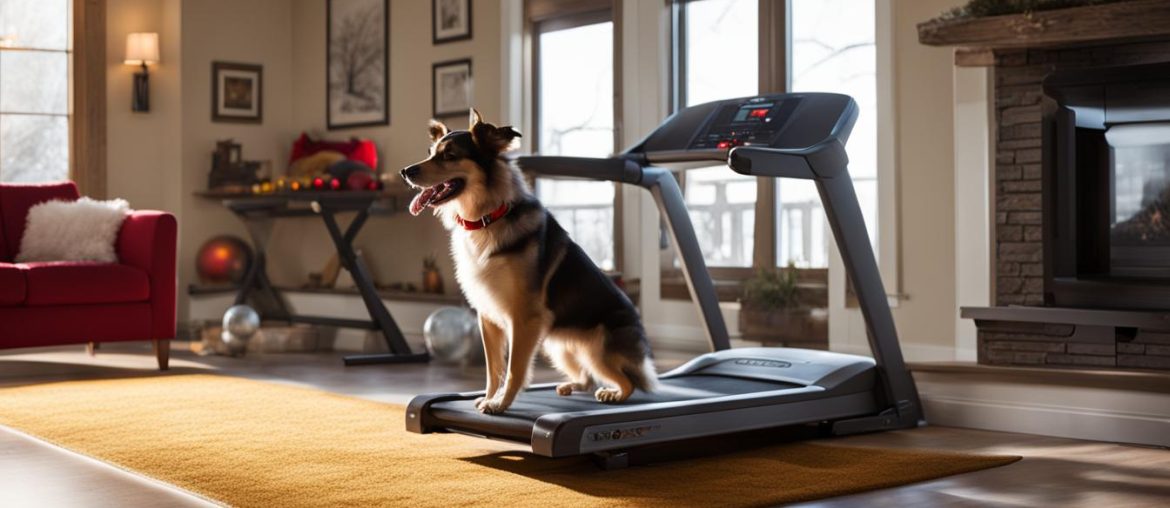As the winter season approaches, remember that exercise is just as crucial for dogs during these colder months. While the chilly weather may make outdoor activities less appealing, there are plenty of ways to keep your furry friend active indoors. With a little creativity and some fun exercises, you can ensure that your dog stays healthy, engaged, and mentally stimulated throughout the winter season.
Key Takeaways:
- Exercise is important for dogs all year round, including the winter months.
- Indoor exercise helps prevent weight gain, promotes good health, and provides mental stimulation.
- Treat dispensing toys, flirt poles, and laser pointers are fun ways to exercise your dog indoors.
- Incorporate training activities and socialize your dog through indoor playdates.
- Consider utilizing indoor exercise equipment and facilities for a more structured workout.
- Training your dog indoors can prepare them for future outdoor activities.
- Indoor exercise benefits both dogs and owners, strengthening the bond between them.
The Importance of Indoor Exercise for Dogs
Exercise is not only important for humans, but also for dogs. It helps prevent weight gain, provides mental stimulation, and promotes overall good health. In the winter, when it may be challenging to exercise outdoors, finding ways to keep your dog active indoors is crucial.
During the colder months, dogs may spend more time indoors, leading to a decrease in physical activity. This sedentary lifestyle can result in weight gain and health issues. Indoor exercise helps to combat these problems by keeping dogs active and engaged.
Engaging in regular indoor exercise also benefits your dog’s mental well-being. Boredom can lead to destructive behaviors such as chewing on furniture or excessive barking. By providing stimulating activities and exercise, you can help keep your dog’s mind occupied and prevent these unwanted behaviors.
“Indoor exercise not only keeps dogs physically fit but also helps to strengthen the bond between dog and owner,” says Dr. Jane Smith, a veterinarian specializing in canine fitness. “It’s an opportunity for quality time and interaction, which is crucial for a dog’s overall well-being.”

Fun Indoor Dog Exercise Ideas
When it’s too cold to exercise your dog outside, there are still plenty of fun indoor activities to keep them active and entertained during the winter months. Here are some creative ideas to get your furry friend moving:
Treat Dispensing Toys
Treat dispensing toys, such as the Classic KONG and StarMark Bob-A-Lot, are excellent options for providing mental stimulation and physical activity for your dog. These toys can be filled with your dog’s favorite treats, challenging them to work for their reward. Not only will they enjoy the tasty treats, but they will also stay engaged and active while trying to retrieve them.
Flirt Poles and Laser Pointers
Flirt poles and laser pointers are exciting tools to get your dog moving indoors. A flirt pole is a long pole with a rope or string attached to a toy or lure at the end. You can use it to mimic prey-like movements, encouraging your dog to chase and pounce. Laser pointers can be used to create quick movements on the walls or floor, captivating your dog’s attention and getting them to chase the elusive light.
Treat Scattering and Snuffle Mats
Make feeding time more engaging by scattering your dog’s kibble or treats around the house. This activity stimulates their natural foraging instincts and keeps them mentally stimulated. Alternatively, you can invest in a snuffle mat – a mat with long strands that you can hide treats within. Your dog will have a blast using their nose to search and find the hidden treasures.
Tug of War, Hide and Seek, and Indoor Obstacle Courses
Tug of war is a classic game that provides both mental and physical stimulation for your dog. Just make sure to use a sturdy rope or toy and teach them the “drop it” command for safety. Hide and seek is another entertaining game you can play with your dog indoors. Have them stay in one room while you hide and then call them to find you. Lastly, you can set up indoor obstacle courses using household items like chairs, blankets, and pillows. Guide your dog through the course, encouraging them to jump, crawl, and weave.

These indoor exercise ideas will not only keep your dog active but also provide mental stimulation to prevent boredom. Try to tailor the activities to your dog’s age, breed, and fitness level. By engaging in these fun and interactive exercises, your dog will stay happy, healthy, and entertained all winter long.
Indoor Exercise Equipment for Dogs
When it comes to keeping your dog active indoors, having the right exercise equipment can make a world of difference. Not only does it provide physical activity, but it also adds mental stimulation to your dog’s routine. Here are some indoor exercise equipment options to consider:
Treat Dispensing Balls
Treat dispensing balls are a great way to combine exercise and mental stimulation for your dog. These balls are designed to hold treats inside, requiring your dog to roll and play with the ball to release the treats. Not only does it keep them entertained, but it also rewards them for their physical activity.
Flirt Poles
A flirt pole is a long pole with a rope or toy attached to the end. It mimics the movement of prey and can be used to engage your dog in a fun game of chase. It’s a great way to get your dog moving indoors and allows them to release their energy in a controlled manner.
Laser Pointers
Laser pointers can be a fun way to engage your dog in exercise. Simply shine the laser on the floor or walls, and watch as your dog chases the elusive light. It provides mental stimulation and gets them moving in a playful manner. However, never shine the laser directly into your dog’s eyes.
Doggy Treadmills
If your dog needs a more intense workout, a doggy treadmill can be a great investment. These treadmills are specifically designed for dogs and provide a controlled environment for them to run or walk indoors. The dogPACER LF 3.1 is a popular option that is both durable and foldable.

To put it simply, choose exercise equipment that is suitable for your dog’s size, breed, and activity level. Always supervise your dog during exercise and ensure that they have access to water at all times. With the right equipment and a little creativity, you can keep your dog active and entertained indoors all year long.
Training Activities for Indoor Exercise
Entertaining your dog indoors can be both fun and beneficial for their mental and physical well-being. One way to keep your dog active indoors is through training activities. Obedience training not only helps your dog learn important commands but also provides mental stimulation and a bonding experience for you and your furry friend. Teaching commands like sit, paw, down, come, wait, and drop it can be done indoors and is a great way to exercise your dog’s mind.
In addition to basic obedience training, you can also explore other training activities such as doga, or dog yoga. Doga focuses on meditating, stretching, and gentle massage for your dog, providing a calming and engaging experience. It can help improve your dog’s flexibility, balance, and overall well-being.
Try to make training sessions fun and rewarding for your dog. Use positive reinforcement techniques such as treats, praise, and playtime to motivate and engage your dog. Keep training sessions short and frequent to maintain your dog’s interest and enthusiasm. With consistent training activities, you can entertain and exercise your dog indoors while strengthening your bond.

Training Activities for Indoor Exercise
“Training your dog indoors not only provides physical exercise but also mental stimulation and bonding time.”
When it comes to entertaining your dog indoors, training activities are a fantastic way to keep them engaged, active, and mentally stimulated. Whether you’re working on basic obedience commands or exploring more specialized activities like doga, training can provide a variety of benefits for both you and your furry companion.
During indoor training sessions, be patient and use positive reinforcement techniques to encourage your dog’s progress. Start with basic commands like sit, stay, and come, and gradually introduce more advanced exercises as your dog becomes more confident and skilled. Try to keep training sessions short and enjoyable, and always end on a positive note.
By incorporating training activities into your dog’s indoor exercise routine, you’ll not only provide them with physical and mental stimulation but also strengthen the bond between you and your furry friend. So grab your treats, set up a dedicated training area, and enjoy the benefits of training your dog indoors!
Socializing and Playdates Indoors
When it’s too cold to venture outside for exercise, inviting a friend or neighbor’s dog over for a playdate is a great way to keep your dog active and socialized. Playdates not only provide physical activity but also help with socialization, which is crucial for a dog’s overall well-being.
To ensure a successful indoor playdate, designate a play area in your home. This can be a basement, garage, or any other space where the dogs have enough room to play safely. If you don’t have a large enough space, you can also set up a playpen to contain the dogs. Make sure to remove any valuable or fragile items from the play area to prevent accidents.
During the playdate, provide toys and games that engage the dogs in physical activity. Tug of war, fetch, and hide and seek are all fun games that can be played indoors. You can even create an obstacle course using household items like pillows and boxes. Be sure to supervise the dogs closely and intervene if any rough play or aggression occurs.
Tips for a Successful Indoor Playdate:
- Choose a calm and neutral location for the playdate.
- Introduce the dogs slowly and allow them to sniff and interact on their own terms.
- Provide plenty of toys and activities to keep the dogs engaged.
- Supervise the playdate closely and intervene if necessary.
- End the playdate on a positive note and reward the dogs with treats or praise.
To put it simply, indoor playdates are not only beneficial for the dogs but also provide an opportunity for owners to socialize and interact with other dog owners. It’s a win-win situation that promotes physical activity, socialization, and overall well-being for both dogs and owners.
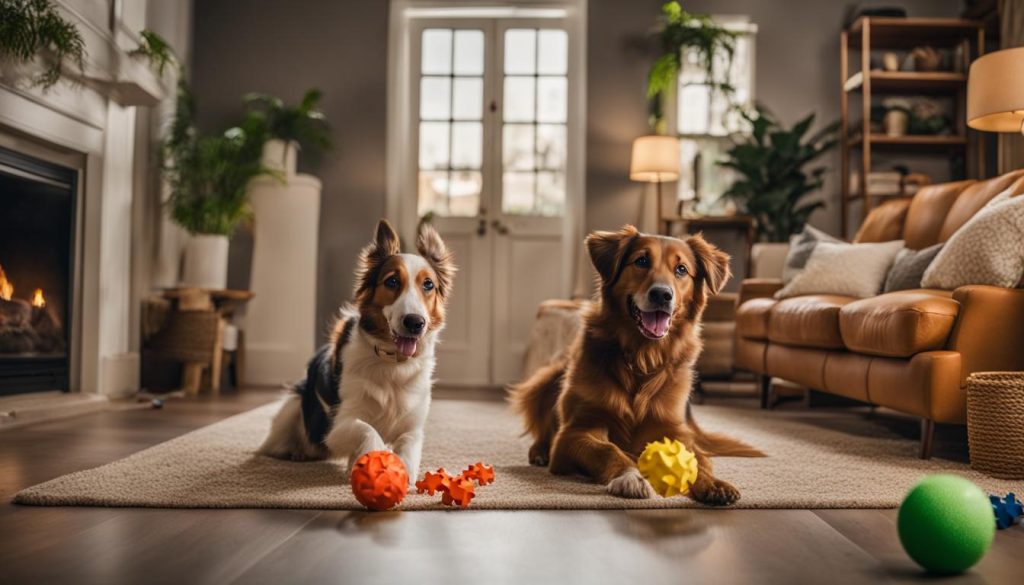
Incorporating Exercise into Everyday Activities
During the winter months, it can be challenging to find opportunities for your dog to get enough exercise outdoors. However, you can still keep your furry friend active by incorporating exercise into your everyday activities. By thinking creatively and making small changes to your routine, you can ensure that your dog stays active and healthy even when it’s cold outside.
Play Fetch in a Large Living Space or Hallway
A simple game of fetch can provide both mental and physical stimulation for your dog. If you have a large living space or a hallway, you can easily play fetch indoors. Use a soft, lightweight ball or a plush toy that won’t break anything if it accidentally hits a wall or piece of furniture. Make sure to clear the area of any valuable or fragile items before starting the game to avoid any accidents.
March Up and Down Stairs Together
Stairs can be a great resource for incorporating exercise into your daily routine. Marching up and down stairs together with your dog can provide a quad workout for you while offering physical activity for your pup. Make sure to go at a pace that is comfortable for both of you and take breaks if needed. This activity not only helps to burn off excess energy but also strengthens the bond between you and your furry companion.
Engage in Squat, Tease, Leap Exercises Using Your Dog’s Favorite Toy
Turn playtime into a workout session by engaging in squat, tease, and leap exercises with your dog’s favorite toy. Squat down and hold the toy just out of reach of your dog to entice them to jump and reach for it. This not only provides physical activity but also helps to improve your dog’s coordination and agility. Try to use a toy that is safe for your dog and avoid any rough play or aggressive tugging.
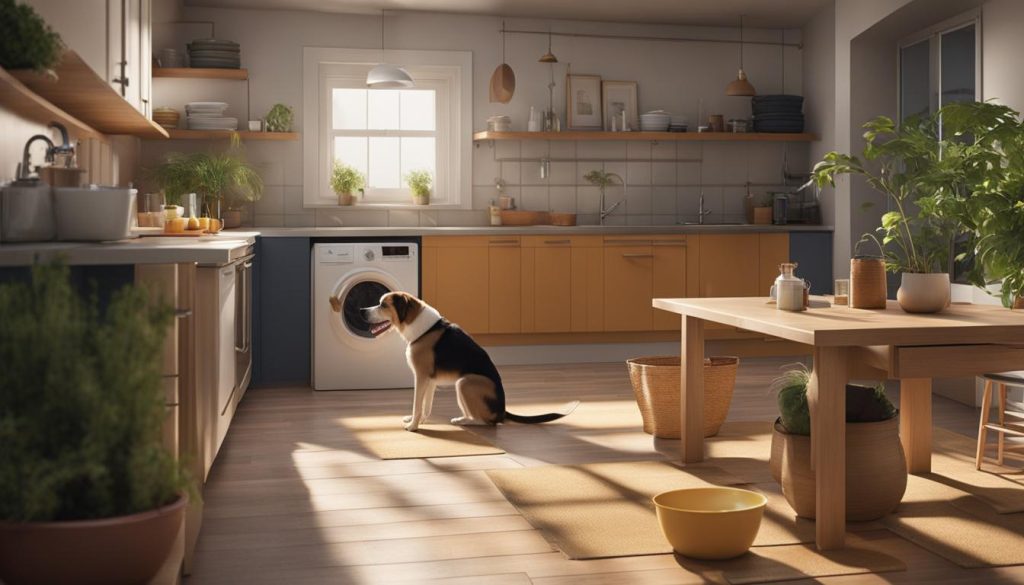
Table: Examples of Indoor Exercises during Daily Tasks
| Daily Task | Indoor Exercise |
|---|---|
| Cooking | Practice obedience commands, such as Sit, Stay, and Down, while you prepare meals |
| Doing Laundry | Play a game of tug of war during the folding process |
| Working from Home | Take short breaks for a quick game of fetch or a brisk walk around the house |
| Cleaning | Set up an indoor obstacle course using household items and guide your dog through it |
| Watching TV | Teach your dog new tricks or practice commands during commercial breaks |
By incorporating exercise into your daily tasks, you can provide your dog with much-needed physical activity and mental stimulation. Try to always prioritize your dog’s safety and choose activities that are suitable for their breed, size, and fitness level. With a little creativity and effort, you can keep your dog active and happy even when going outside is not an option.
Indoor Exercise Classes and Facilities
When it comes to providing your dog with the opportunity to exercise indoors, there are a variety of options available. Many communities have indoor pet centers or facilities specifically designed to cater to the exercise needs of dogs. These facilities provide a safe and controlled environment for both dogs and owners to engage in physical activities.
Indoor pet centers often have designated areas for games of fetch, running tracks, and even swimming pools. These amenities allow dogs to engage in high-energy activities that promote physical fitness and mental stimulation. Additionally, these centers may offer training classes and agility courses to further enhance your dog’s exercise routine.
By taking advantage of indoor pet centers, you can ensure that your dog gets the exercise they need, regardless of the weather outside. These facilities provide a convenient and controlled environment where you can engage in activities that will keep your dog active and healthy.

Comparison of Indoor Pet Centers
| Indoor Pet Center | Location | Facilities | Additional Services |
|---|---|---|---|
| Paw Play | City A | Indoor running track, swimming pool, play areas | Obedience classes, grooming services |
| Doggy Fun Zone | City B | Agility course, ball pit, obstacle course | Behavioral training, daycare services |
| Bark-n-Play | City C | Indoor fetch area, sensory garden, training zone | Pet photography, retail store |
The table above showcases a comparison of three popular indoor pet centers in different cities. Each center offers a range of indoor exercise facilities, along with additional services to cater to the needs of dog owners. Whether you’re looking for a place to let your dog run, swim, or participate in training classes, these indoor pet centers provide ample opportunities for exercise and socialization.
Training Your Dog for Outdoor Exercise in the Future
While it may be too cold to go outside in the winter, you can use this time to train your dog for outdoor exercise in the future. By focusing on obedience training and reinforcing commands, you can prepare your dog for a variety of outdoor activities once the weather improves.
One training activity you can work on indoors is leash training. Practice walking or running with your dog on a leash, ensuring they understand commands like “heel” and “stop.” This will help them stay focused and controlled during outdoor walks or runs.
Another important aspect of outdoor exercise is recall training. Practice calling your dog to come to you from different areas of your home. Use treats or toys as positive reinforcement to encourage them to come when called. This will be especially useful when you’re in outdoor environments with distractions.
Incorporate training activities that mimic outdoor exercises. For example, set up obstacles in your home or backyard for your dog to navigate. This will help them develop agility and balance, preparing them for activities like hiking or agility courses.
Try to be patient and consistent in your training efforts. It may take time for your dog to fully grasp outdoor exercise commands and behaviors, but with practice and positive reinforcement, they will become well-prepared for outdoor adventures.
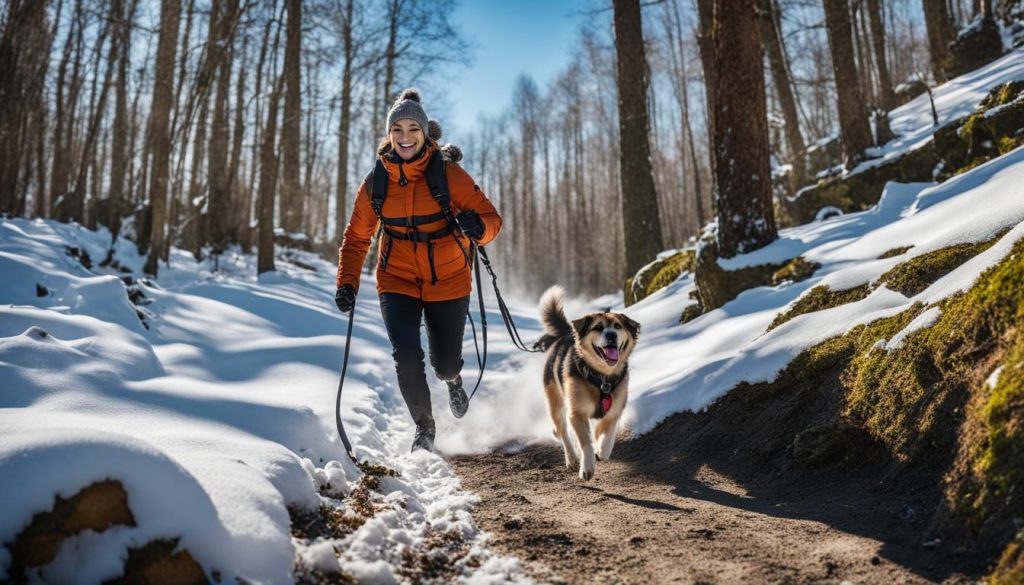
Table: Indoor Training Exercises
| Exercise | Description |
|---|---|
| Leash Training | Practice walking or running with your dog on a leash indoors, reinforcing commands like “heel” and “stop.” |
| Recall Training | Work on calling your dog to come to you from different areas of your home, using treats or toys as positive reinforcement. |
| Obstacle Course | Set up obstacles in your home or backyard for your dog to navigate, helping them develop agility and balance. |
By incorporating these training exercises into your indoor routine, you can ensure that your dog is well-prepared for outdoor exercise once the weather allows. Try to adjust the difficulty level based on your dog’s abilities and progress gradually. With consistent training and positive reinforcement, your dog will be ready to enjoy outdoor adventures with you.
The Benefits of Indoor Exercise for Dogs and Owners
Indoor exercise provides numerous benefits for both dogs and their owners. Not only does it help prevent weight gain in dogs, but it also promotes mental and physical stimulation, leading to a healthier and happier pet. Regular indoor exercise strengthens the bond between dog and owner, as they engage in activities together. This shared experience enhances the emotional connection and fosters a sense of companionship.
For owners, participating in indoor exercise with their dogs allows them to stay active and incorporate physical activity into their daily routine. This can be especially beneficial for individuals with busy schedules or limited outdoor access due to weather conditions. Engaging in indoor exercise helps owners maintain their own fitness levels while ensuring their furry companions receive the exercise they need.
Indoor exercise plays a crucial role in mitigating destructive behaviors caused by excess energy. Dogs who do not get enough physical and mental stimulation may resort to chewing furniture or engaging in other destructive activities. By providing regular indoor exercise, owners can help channel their dog’s energy in a positive and controlled manner, reducing the likelihood of destructive behavior.
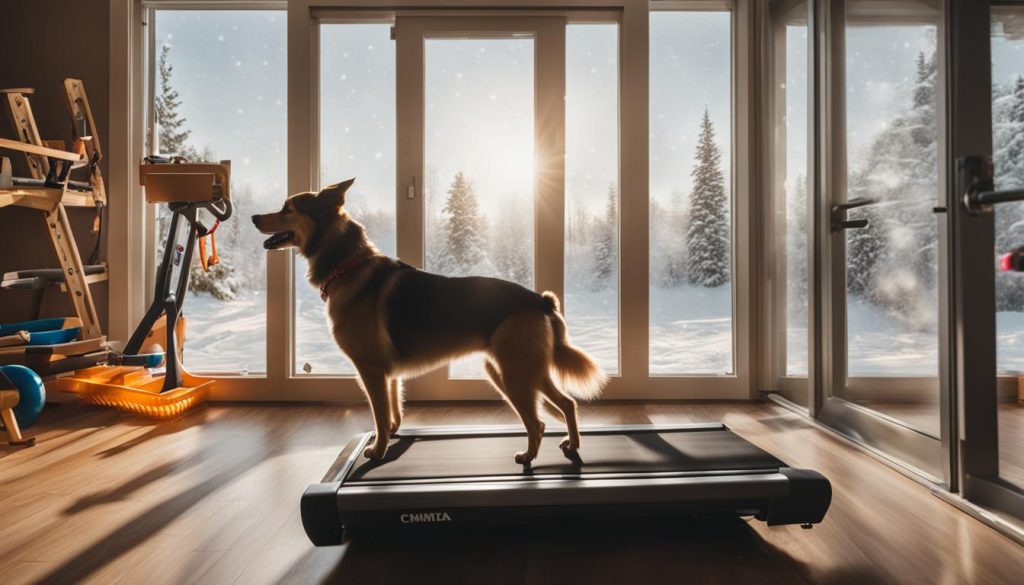
In summary, the benefits of indoor exercise for both dogs and owners are significant. From keeping dogs physically fit and mentally stimulated to strengthening the bond between dog and owner, indoor exercise plays a vital role in maintaining overall health and well-being. So, during the winter months or when outdoor exercise is not possible, make sure to engage in creative and fun indoor activities with your dog to ensure a happy and healthy lifestyle for both of you.
Final Thoughts
Indoor exercise is essential for keeping dogs healthy, active, and mentally stimulated, especially during the winter months. By incorporating a variety of creative indoor exercise activities, utilizing exercise equipment, and focusing on training activities, you can ensure that your dog stays happy and engaged all season long.
Try to tailor the exercises to your dog’s specific needs, breed, size, and any health considerations. Treat dispensing toys, flirt poles, and laser pointers can provide both mental and physical activity. Additionally, training activities and playdates with other dogs can help with socialization and mental stimulation.
Indoor exercise not only benefits dogs, but also their owners. It strengthens the bond between dog and owner, helps prevent weight gain in dogs, and mitigates destructive behaviors caused by excess energy. Plus, it’s an opportunity for owners to stay active and exercise alongside their furry companions. So, embrace the winter season and make the most of indoor exercise to keep your dog happy and healthy!
FAQ
Is exercise essential for dogs during the winter?
Yes, exercise is important for dogs all year round, including the winter months. It helps prevent weight gain, promotes good health, and provides mental stimulation.
How can I exercise my dog indoors during the winter?
There are many fun and creative ways to exercise your dog indoors during the winter. You can use treat dispensing toys, flirt poles, laser pointers, treat scattering, snuffle mats, tug of war, hide and seek, and indoor obstacle courses to keep your dog active.
Do I need to purchase exercise equipment for indoor dog exercise?
In some cases, you may need to purchase or construct exercise equipment to keep your dog active indoors. Treat dispensing balls, flirt poles, laser pointers, and doggy treadmills are examples of equipment that can be used to exercise your dog indoors.
Can I combine indoor exercise with training activities for my dog?
Yes, you can incorporate exercise into your dog’s training activities to provide mental stimulation. Obedience training, such as teaching commands like Sit, Paw, Down, Come, Wait, and Drop it, can be done indoors. Doga, or dog yoga, is another training activity that focuses on meditating, stretching, and dog massage.
Are indoor playdates beneficial for my dog?
Yes, inviting a friend or neighbor’s dog over for a play date is a great way to keep your dog active and socialized indoors. It provides physical activity and helps with socialization.
How can I incorporate exercise into my daily tasks with my dog?
You can play fetch in a large living space or hallway, march up and down stairs together for a quad workout, or engage in exercises like squat, tease, leap using your dog’s favorite toy.
Are there indoor pet centers or facilities for exercising with dogs?
Yes, many communities have indoor pet centers or facilities that provide space for exercising with your dog indoors. These facilities may have designated areas for games of fetch, running tracks, and even swimming pools.
How can I train my dog for outdoor exercise in the future during the winter?
While it may be too cold to go outside in the winter, you can use this time to train your dog for outdoor exercise in the future. Practice running on a leash indoors and reinforce obedience commands.
What are the benefits of indoor exercise for dogs and owners?
Indoor exercise provides numerous benefits for both dogs and their owners. It helps prevent weight gain in dogs, improves mental and physical stimulation, strengthens the bond between dog and owner, and mitigates destructive behaviors caused by excess energy.
How important is indoor exercise for dogs during the winter?
Indoor exercise is crucial for dogs during the winter months. It helps keep them healthy, active, and mentally stimulated. By incorporating creative indoor exercise activities, utilizing exercise equipment, and focusing on training activities, you can ensure that your dog stays active and happy all season long.


